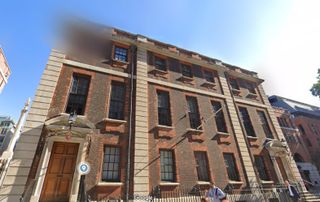How the Church of England is switching to heat pumps and solar panels — starting with St Paul’s Cathedral (well, part of it)
The religious body has made a commitment to improving the energy efficiency of its buildings in the hope that the Church will be Net Zero by 2023

The Church of England has made a huge commitment to achieving net-zero by 2030 and is installing heat pumps and solar panels in its buildings to help safeguard "God’s creation".
Houses of worship throughout the country are taking simple actions like switching to LED lightbulbs, as well as undertaking large capital works like the installation of solar panels.
One of its initiatives was to install aground source heat pumpat St Paul Cathedral’s Georgian Chapter House in a bid to reduce the property’s carbon footprint.
Church of England plans to be Net Zero by 2030
In February 2020 the General Synod – the national assembly of the Church of England – announced its intention to reach net zero carbon across its parish, cathedral, diocesan, and school estates by 2030.
A key part of this is making use of technological solutions in its buildings and disinvesting from organisations that fail to meet their environmental obligations.
A joint statement from the Bishop of Norwich, the Rt Revd Graham Usher, and the Bishop of Selby, the Rt Revd Dr John Thomson, reads: “The 2030 target is hugely ambitious, but the process is as important as the target.
“Every month or year that we delay our progress towards net zero carbon will lead to suffering and even death for our human neighbours and the rest of God’s creation.
“It is thus a matter of justice that we act now and is a key part of our obedience to God’s call to care for creation that the transition to net zero carbon takes place as rapidly as possible.”
17 boreholes over 100 metres deep installed into historic building
The Grade II* listed St Paul's Cathedral Chapter House was designed and built by Sir Christopher Wren and his son in 1715, is located next to the iconic Cathedral, and houses two rooms for receptions and dinners.
Martin Fletcher, Clerk of the Works at St Paul’s Cathedral, outlines how they undertookinstalling a ground source heat pumpcentral heating system during an extensive refurbishment of the Chapter House, which was previously served by two "really big" gas boilers.
Now it is heated by a vertical loop ground source pump system using 17 boreholes of between 100 and 111 metres – four kilometres of pipework in total. These boreholes were drilled through the floor of masonry workshops in 2014 below ground between St Paul's Cathedral and the Chapter House. This was for minimal disturbance to "archaeological layers" elsewhere around the Cathedral.
He said: “Insulationis a major part of any ground source or air source heat heating system, you must be well-insulated.”
热也显然从计算机服务器使用in the building and energy in air extracted from a newly-installed mechanical ventilation with heat recovery (MVHR) system is also used to treat incoming air. The ductwork for this was hidden inside a chimney stack in the roof and fan coils were concealed in the internal timberwork.
Double glazing was also added to the building along with roof insulation.
For every kwh you put in you get 3-4 out
Ground source heat pumps transfer heat from the ground to radiators, air conditioning units, orunderfloor heating. They use a thermal transfer fluid in a loop of pipe bored deep into the ground to absorb ground heat and transfer it into the building.
They need electricity to operate, but tapping into the energy stored underground allows them to be more efficient and environmentally friendly than fossil fuel heating and cooling systems.
Martin Fletcher added: “For every kilowatt you put in you get about three or four kilowatts out, so that’s where the saving is.”
Get the Homebuilding & Renovating Newsletter
Bring your dream home to life with expert advice, how-to guides and design inspiration, direct to your inbox.
Sam is based in Coventry and has been a news reporter for nearly 20 years. His work has featured in the Mirror, The Sun, MailOnline, the Independent, and news outlets throughout the world. As a copywriter, he has written for clients as diverse as Saint-Gobain, Michelin, Halfords Autocentre, Great British Heating, and Irwin Industrial Tools. During the pandemic, he converted a van into a mini-camper and is currently planning to convert his shed into an office and Star Wars shrine.
Most Popular


BySam Webb
Bring your dream home to life with expert advice, how-to guides and design inspiration, direct to your inbox.
Thank you for signing up to Homebuilding. You will receive a verification email shortly.
There was a problem. Please refresh the page and try again.
